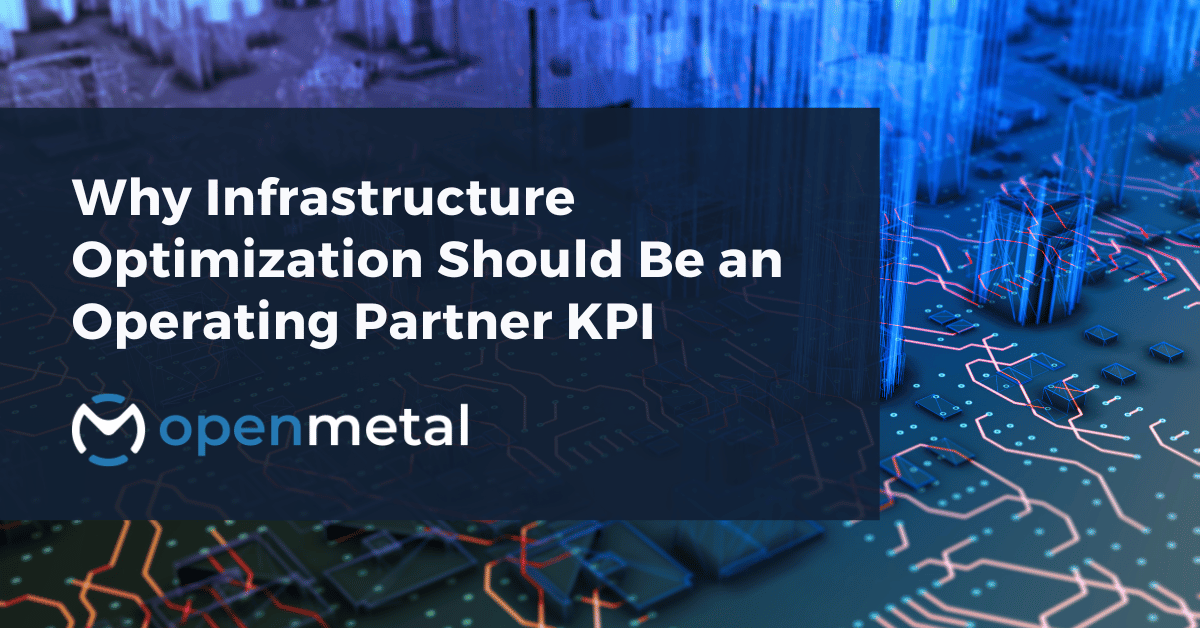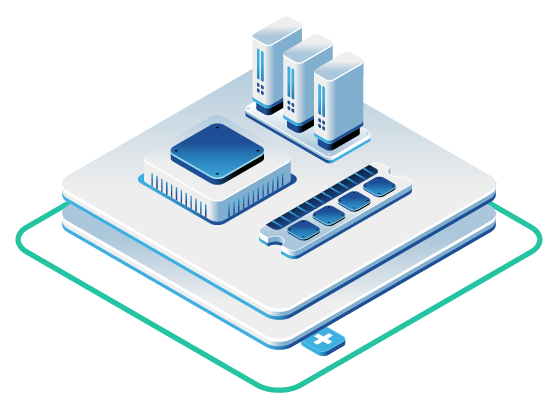
When you’re evaluating portfolio companies for operational improvements, you probably focus on sales performance, marketing efficiency, or workforce optimization. But here’s what might surprise you: infrastructure costs often represent one of the largest untapped opportunities for EBITDA improvement in your portfolio.
According to the Flexera 2024 State of the Cloud report, 84 percent of organizations cite cost optimization as their top cloud initiative1. Yet most private equity operating partners still treat infrastructure as a back-office concern rather than a measurable driver of financial performance. It’s time to change that perspective.
The Hidden Infrastructure Drain on Portfolio Performance
Your portfolio companies are likely experiencing infrastructure cost creep that directly impacts their bottom line. Cloud bills don’t just grow predictably—they explode with hidden charges, unused resources, and pricing models that become increasingly expensive as companies scale.
When private equity operating partners look for ways to improve a company’s performance, they often focus on sales, marketing, or staffing. But one of the biggest hidden costs is usually in infrastructure. Cloud bills can grow fast, especially with extra charges like data transfer fees. Companies also run into waste from servers that sit unused, or from complicated storage setups that slow down their work.
Private equity firms often deal with many cloud services, accounts and instances across their portfolio companies. This decentralized environment requires more centralized visibility into cloud spending, making it challenging to track expenses accurately, especially as the cloud environment increases in size and complexity2.
Here’s what you need to understand: infrastructure costs can reach 50% of total cost of revenue for software companies, and these expenses often grow faster than revenue. That directly impacts the EBITDA margins that determine your portfolio company valuations.
Why Traditional Infrastructure Management Fails PE Objectives
Most portfolio companies manage infrastructure reactively, responding to problems instead of treating it as a strategic business function. This approach creates several problems that directly conflict with your value creation goals:
Unpredictable Cost Escalation: Overprovisioning and underutilization of cloud resources are common issues within portfolio company operations. The combination of complex and fluctuating cloud workloads due to organizational transformation, coupled with unpredictable cloud resource usage patterns make it challenging to optimize cloud resources effectively. You can’t budget accurately when your infrastructure costs swing wildly month to month.
Resource Waste: In typical public cloud deployments, companies use roughly 30% of allocated resources on average, yet pay for 100% of those resources whether they use them or not. That’s pure waste hitting your margins.
Acquisition Integration Challenges: When you acquire companies, you inherit diverse IT infrastructures with different cloud contracts and configurations. Without a systematic approach to infrastructure optimization, these complexities compound across your portfolio.
Growth-Driven Inefficiencies: Growth initiatives often entail the deployment of new applications, expansion into new regions and handling increased user traffic. These growth-driven workloads can result in unpredictable resource utilization and fluctuating cloud costs, making it challenging to forecast expenses accurately.
Making Infrastructure a Measurable KPI
The solution isn’t just cutting infrastructure spend—it’s making infrastructure efficiency a trackable, measurable KPI that drives consistent value creation across your portfolio. Here’s how successful operating partners are approaching this:
Cost Predictability as Performance: Instead of accepting variable cloud costs as inevitable, establish fixed infrastructure spending targets that companies can plan around. This transforms infrastructure from an unpredictable expense into a manageable budget line item.
Resource Utilization Metrics: Track actual resource usage versus allocated resources across portfolio companies. Companies consistently achieving 70-80% utilization demonstrate superior infrastructure management compared to the industry average of 30%.
Performance-to-Cost Ratios: Measure application performance relative to infrastructure investment. Companies that can maintain or improve performance while reducing per-unit infrastructure costs are demonstrating operational excellence.
Margin Impact Tracking: Directly tie infrastructure efficiency improvements to gross margin improvements. Research shows that high-growth software companies often trade at 24-25x gross profit multiples, meaning every dollar saved through infrastructure optimization translates to $24-25 in market capitalization gains.
The OpenMetal Approach to Infrastructure KPIs
With OpenMetal, infrastructure can be set up in a way that avoids these problems. The servers are dedicated, meaning companies have full control and know exactly what resources they are using. Costs don’t change month to month because pricing is fixed, making it easier to plan.
For example, a Large V4 server comes with Intel Xeon CPUs, 512 GB of memory, and Micron 7500 NVMe drives, which are built for production workloads. For heavier needs, GPU servers with NVIDIA L40s handle things like machine learning or graphics tasks. Storage is handled with Ceph clusters, which grow smoothly as data grows. This means companies can manage big sets of blockchain data, SaaS information, or AI training data without hitting bottlenecks.
This approach creates several measurable advantages:
Fixed Cost Structure: Unlike public cloud’s variable pricing, dedicated infrastructure provides predictable monthly costs that make budgeting and margin planning straightforward.
Full Resource Utilization: When you lease all the resources of physical hardware rather than virtual slices, unused capacity from one workload remains available for other applications. This eliminates the waste inherent in shared cloud models.
Performance Consistency: Dedicated resources mean consistent performance without the “noisy neighbor” problems that can impact customer experience in shared environments.
Scalable Architecture: Ceph storage clusters grow smoothly with data requirements, avoiding the storage bottlenecks that can limit business growth or trigger expensive data migration projects.
By moving to this type of setup, companies can turn infrastructure from a messy, unpredictable cost into something steady and easy to measure. For operating partners, this makes it possible to track infrastructure efficiency as a key performance indicator, right alongside other business measures.
Implementing Infrastructure KPIs Across Your Portfolio
An effective starting place is to perform an assessment to derive the current state of FinOps maturity. The desired outcome should yield results that establish a digestible baseline with outputs for activities such as creating a roadmap for desired end state, compliance benchmarking, remediation, and optimization opportunities.
Here’s a practical framework for implementing infrastructure optimization as an operating partner KPI:
- Baseline Assessment: Conduct infrastructure audits across portfolio companies to understand current spending patterns, resource utilization rates, and cost allocation methods. This establishes your starting point for improvement tracking.
- Standardized Metrics: Implement consistent infrastructure metrics across portfolio companies, including cost per customer, infrastructure cost as percentage of revenue, and resource utilization rates.
- Performance Targets: Set specific infrastructure efficiency targets, such as achieving 70% resource utilization or reducing infrastructure costs by 30% while maintaining performance levels.
- Regular Reporting: Include infrastructure efficiency metrics in monthly portfolio company reports, treating them with the same importance as sales and marketing KPIs.
- Incentive Alignment: Tie management bonuses to infrastructure efficiency improvements to ensure sustained focus on optimization efforts.
The Financial Impact of Infrastructure KPIs
The numbers speak for themselves when it comes to infrastructure optimization’s impact on portfolio value. Consider Dropbox’s infrastructure optimization initiative, which saved nearly $75 million over two years by shifting workloads from public cloud to custom-built infrastructure, with gross margins increasing from 33% to 67%.
Research from Andreessen Horowitz estimates that $100 billion of market value is being lost among the top 50 public software companies due to cloud impact on margins. For your portfolio companies, this represents both a significant risk and an enormous opportunity.
When you implement infrastructure optimization as a systematic KPI across your portfolio, you create multiple value creation opportunities:
Immediate EBITDA Improvement: Direct cost savings from infrastructure optimization flow straight to the bottom line, often representing 5-15% EBITDA improvement for software companies.
Valuation Multiple Expansion: Companies demonstrating consistent gross margin improvement through operational excellence often command higher valuation multiples than their peers.
Exit Value Creation: Buyers increasingly value companies with predictable, optimized infrastructure costs, as it demonstrates management sophistication and reduces integration risks.
Portfolio-Wide Best Practices: Successful infrastructure optimization at one portfolio company can be systematically applied across similar companies, multiplying value creation opportunities.
Making Infrastructure Optimization Standard Practice
FinOps is a journey that can be incrementally iterated upon to reshape fiscal responsibility as a practice that starts to consider technology as a value driver rather than a cost2. The most successful private equity firms are already treating infrastructure optimization as a standard part of their value creation playbook.
This approach requires shifting from reactive infrastructure management to proactive optimization strategies. Instead of only addressing infrastructure problems when they impact operations, you establish systematic processes for continuous improvement and cost control.
The key is starting early in the investment lifecycle. Companies approaching $1 million in annual cloud spend should begin evaluating infrastructure optimization opportunities, as this threshold often represents the point where optimization efforts justify the transition costs.
For SaaS companies specifically, the decision between private and public cloud often comes down to scale and workload characteristics. Research indicates that repatriating $100 million of annual public cloud spend typically translates to less than half that amount in total cost of ownership for equivalent private infrastructure.
Your Next Steps as an Operating Partner
Infrastructure optimization shouldn’t be an afterthought in your value creation strategy. When you make it a measurable KPI, you gain visibility into one of the largest controllable costs in modern businesses while creating systematic improvement processes that compound over time.
The companies in your portfolio that master infrastructure efficiency will outperform peers on margins, demonstrate more predictable cost structures, and command higher valuations at exit. Those that continue treating infrastructure as a back-office concern will find themselves at a competitive disadvantage as markets increasingly value operational excellence.
Start by conducting infrastructure assessments across your portfolio to identify the companies with the greatest optimization opportunities. Focus first on software companies with predictable workloads and growing cloud costs—these typically deliver the fastest and most measurable improvements.
Remember, infrastructure optimization isn’t just about cutting costs—it’s about creating predictable, scalable foundations that support portfolio company growth while protecting margins.
Ready to make infrastructure optimization a systematic value driver across your portfolio? OpenMetal’s private cloud platform provides the predictable costs, dedicated resources, and performance consistency that make infrastructure efficiency measurable and manageable.
Discover how OpenMetal can help optimize your portfolio’s infrastructure costs →
[1] Flexera. “Flexera 2024 State of the Cloud Report.” 2024.
[2] Protiviti. “Controlling Cloud Cost Challenges in Private Equity: How FinOps Leads the Way.” November 12, 2024.
Read More on the OpenMetal Blog


































